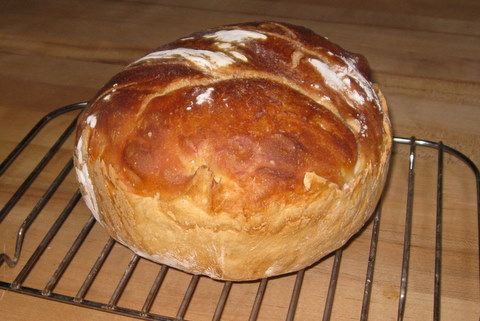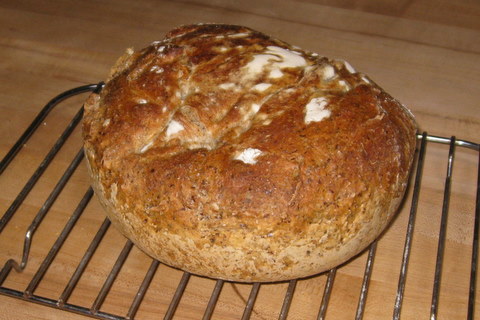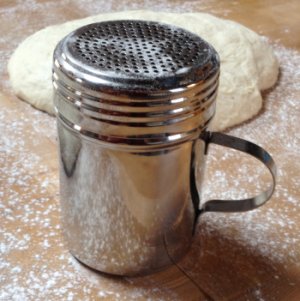chrisinmtown.github.io
Baking No-Knead Bread
3 Oct 2010
First I’ll bore you with the back story. When we were in gradual school at UMCP and had more time than we do now, my buddies Bill, Scott and I made valiant attempts at baking decent bread at home. This was before good bakeries popped up everywhere, and long before grocery stores received par-baked loaves to finish daily. Occasionally we’d get something almost edible but never good enough to motivate us to make it again soon. Then I spent a few years in Germany where good bread was everywhere, and never baked. When we moved to New Jersey over a decade ago there was some good bread around and even tho I finally had a kitchen to mess up, I still didn’t attempt any bread.
Then late in 2008 I stumbled across Mark Bittman’s article in the NY Times on baking no-knead bread (links are below). I printed it out and it lay on my desk for a solid year. Maybe it was longer, I don’t know. Finally in some fit of desk cleaning I unearthed the sheet and forced myself to make it.
Before I go any further, here is a link to the recipe at The New York Times, and for good measure a link to the Sullivan Street Bakery:
http://www.nytimes.com/2006/11/08/dining/081mrex.html
http://www.sullivanstreetbakery.com/
Making the dough is almost no work. Back in grad school we were too impatient to knead the dough enough, and this recipe solves that problem. To bake this bread you need a medium-size oven-proof container with an oven-proof lid, ideally ceramic. Well, I used a makeshift system of a mixing bowl and an inverted frying pan. (Once I almost melted the bakelite knob on a frying-pan lid, but don’t tell the wife.)
So my very first loaf emerged from this ridiculous bowl and frying pan contraption .. just amazing. It looked like, well, like a real loaf of bread. It tasted GREAT. The kids and I ate it in, uh, probably about an hour. I made another loaf immediately, baked it the next day. The second loaf, despite my best attempts to mess it up, was great too. Hmm. Suddenly baking bread got a lot more attractive. Here’s a picture of today’s loaf of white bread, just the straight recipe.

Eventually I experimented a bit. I have found that this recipe works just fine with whole-wheat flour or rye flour, but not more than about 1/3 of the total flour. One more picture, this is a loaf with about 1/3 rye flour and maybe a quarter cup of some goofy flax seed that I found in the pantry. It doesn’t rise as much as an all-white-flour loaf but the taste is a lot more interesting.

This has become my standard thing to take to other people’s houses. Their kids usually devour it, even the rye version. I also found a smallish ceramic pot with a ceramic lid that has become my standard bread baker, just got lucky at the local home-goods store that sells remnants etc.
I’ll wrap this up with a big thank-you to Jim Lahey for sharing the fruits of his research, and also many thanks to Mark Bittman for writing it up!
Update 18 Feb 2012
After seeing a friend use a shaker to distribute flour evenly when making gravy, I finally got one for making bread. It works great!! This is probably something totally obvious to real bakers but it took me a long time to stumble upon it. That’s today’s loaf rising in the background, sitting on top of a silicone baking sheet liner that is nicely covered with flour from the shaker.

Here’s the plain-text recipe, just in case those links above ever stop working. I sure hope they don’t mind me repeating the recipe here.
baking the perfect
loaf of bread at home
Formula and process created by
Jim Lahey, owner of Sullivan St Bakery.
formula
3 cups (430g) flour
1 1/2 cups (345g or 12oz) water
1/2 teaspoon (1g) yeast
1 1/4 teaspoon (8g) salt
olive oil (for coating)
extra flour, wheat bran, or cornmeal (for dusting)
equipment
Two medium mixing bowls
6 to 8 quart pot with lid
(Pyrex glass, Le Creuset cast iron, or ceramic)
Wooden Spoon or spatula (optional)
Plastic wrap
Two or three cotton dish towels (not terrycloth)
process
Mix all of the dry ingredients in a medium bowl.
Add water and incorporate by hand or with a wooden
spoon or spatula for 30 seconds to 1 minute. Lightly
coat the inside of a second medium bowl with olive oil
and place the dough in the bowl. Cover the bowl with
plastic wrap and let the dough rest 12 hours at room
temperature (approx. 65-72 degrees F).
Remove the dough from the bowl and fold once or twice.
Let the dough rest 15 minutes in the bowl or on the work
surface. next, shape the dough into ball. Generously
coat a cotton towel with flour, wheat bran, or cornmeal;
place the dough seam side down on the towel and dust with
flour. Cover the dough with a cotton towel and let rise
1-2 hours at room temperature, until more than doubled in
size.
Preheat oven to 450-5000F. Place the pot in the oven at
least 30 minutes prior to baking to preheat. Once the dough
has more than doubled in volume, remove the pot from the
oven and place the dough in the pot seam side up. Cover
with the lid and bake 30 minutes Then remove the lid and
bake 15-30 minutes uncovered, until the loaf is nicely browned.
Blog index / feedback to christopher döt lott át gmail dðt com